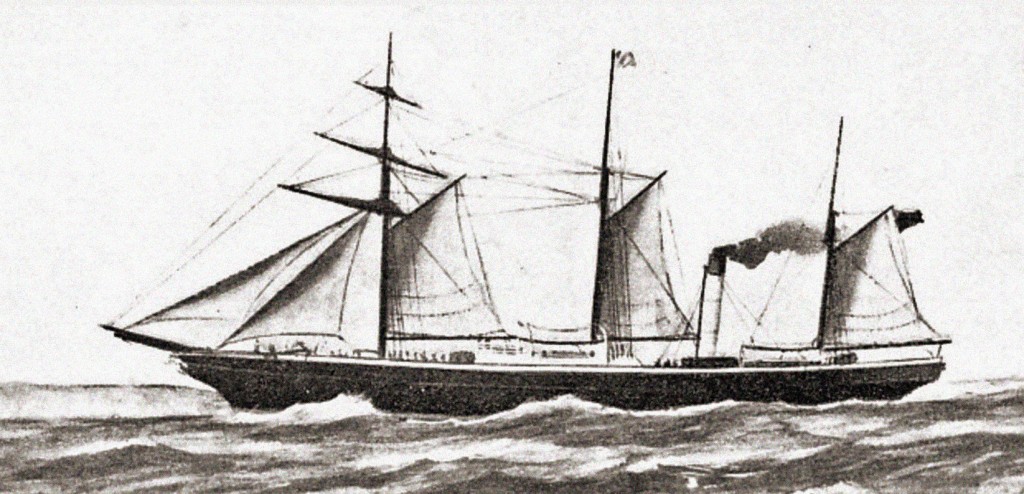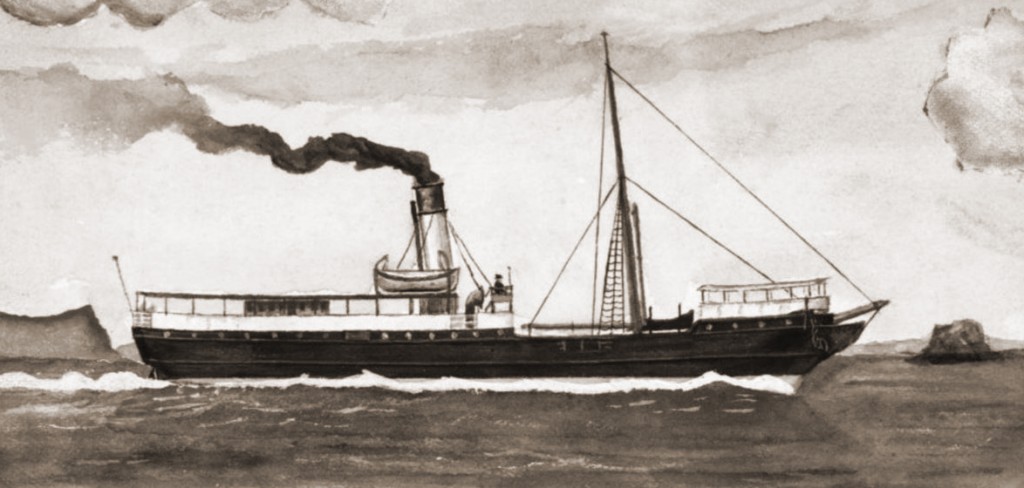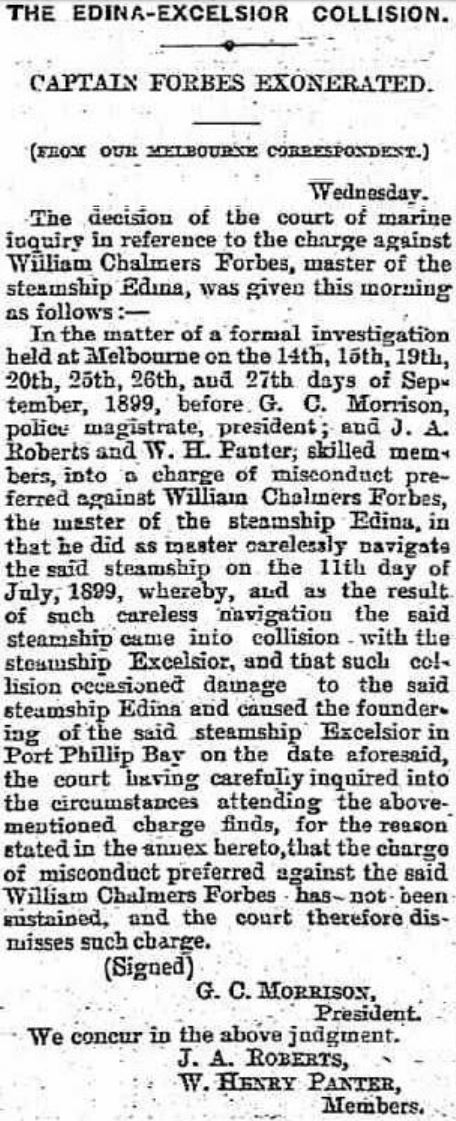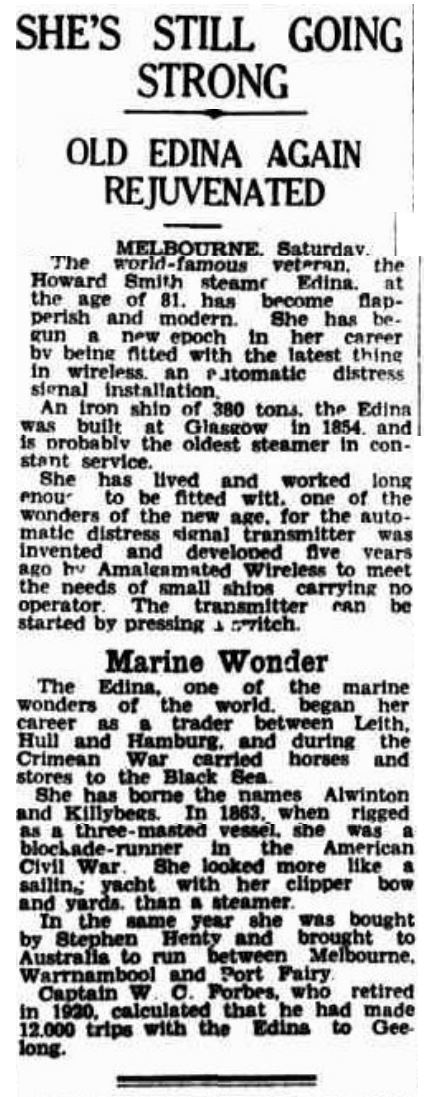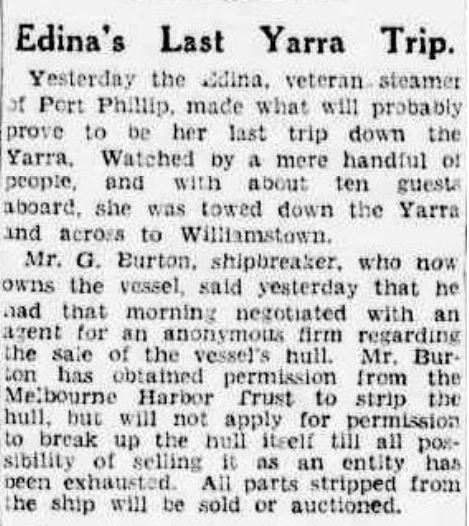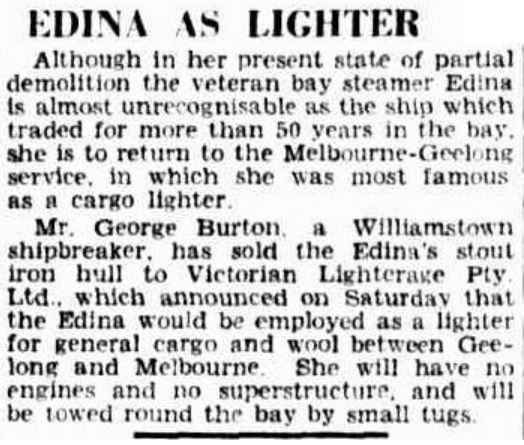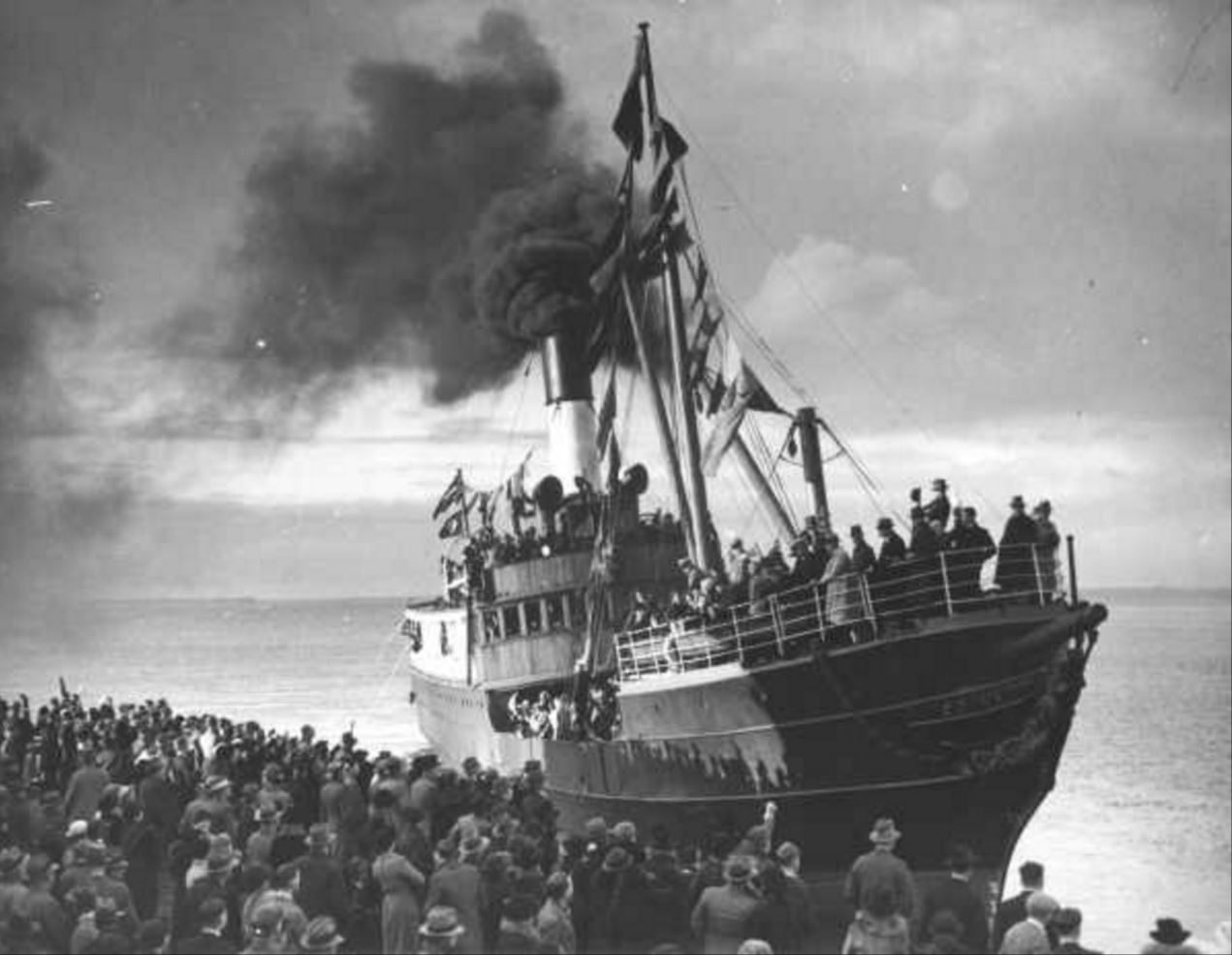The SS ‘Edina’ was a screw steamer, built by Barclay & Curle, in Glasgow, Scotland, in 1854.
The SS ‘Edina’ is one of the most remembered vessels that plied the waters of Victoria’s Port Phillip Bay. Often referred to as the ‘Old Lady of Port Phillip’, she became the longest serving Screw Steamer in the World !!!
Her active service included the North Sea trade, ‘Crimean War’, ‘American Civil War’, Victoria’s west coast run, New Zealand to Melbourne trade, Queensland coastal trade, and of course, the Port Phillip Bay runs between the years 1880 to 1938.
‘SS’ being an abbreviation for ‘Screw Steamer’ signifying that she was propelled by a steam engine rotating a single propeller, or ‘screw’ as it was know at the time.
The Evolution of ‘Steamers’
Over time, paddle steamers proved to be somewhat disadvantaged in times of rough seas when the rolling action would often see a paddle out of the water and the other in too deep. There was also the concern as the loading of passengers and cargoes which increased and decreased the draught of the vessel and hence the inefficiencies of the paddle wheels as they went deeper or shallower. Wartime also recognised that the paddle wheels were so exposed and at risk of being blown to pieces.
With the invention of the ‘stuffing-box’ which prevents water entering the hull of a ship, the screw propeller, and the horizontal rather than vertical steam engine, the advantages of this new form of propulsion became more and more apparent. Screw propulsion meant that the engine and propeller were under the water level, and, the propeller was at risk of exposure during rough seas, nor did the level of the ship in the water matter.
Screw steamers became increasingly popular from the mid 1840’s onwards . . .
Gross Tonnage: 377
Net Tonnage: 223
Length: 171 ft (52.12 m)
Beam: 23 ft 6 in (7.16 m)
Depth: 12 ft 7 in (3.84 m)
Engines: A & J Inglis Ltd. – 60 hp
First Owner: Leith, Hull & Hamburg Steam Packet Co Ltd – (Manager: J. Currie & Co.)
Timeline:
7 May 1854 → the iron passenger & cargo three masted screw steamer, the SS ‘Edina’, was launched. She was graceful in design with yacht like lines and a graceful clipper-like bow which adorned the ‘Fair Maid of Judea’ figure-head. Sadly, the figure-head was smashed into pieces when the ‘Dandenong’ struck her in a gale off Warranambool, Victoria
The SS ‘Edina’ ran the cross Channel service between Leith & Hull, UK and Hamburg, Germany
28 Feb 1855 → the SS ‘Edina’ was requisitioned by the British Admirality and became HMS ‘Edina’ during the ‘Crimean War’ where she was used to carry ammunition, horses, stores and supplies from Deptford, UK to the Black Sea. At a remuneration quoted at a meager sum of £2 15s per ton per month, the SS ‘Edina’ proved to be relatively economical as under sail, her coal consumption was greatly reduced . . .
Mar 1856 → the SS ‘Edina’ was returned to her owners where she returned to her English Channel runs, transporting cargoes from Europe across the North Sea to the River Elbe
1861 → following the installation of a new boiler, the SS ‘Edina’ was again requisitioned, this time to serve in the ‘American Civil War’ where she completed at least 6 trips from Galveston, Texas loaded with cotton bales destined for England and France
23 Nov 1862 → T. Callender & A. Walker of Melbourne, Victoria acquired the SS ‘Edina’. She left England after having her screw removed – sailing across to Australia arriving in Melbourne on the 7th March 1863
1863 → Stephen G Henty of Melbourne, Victoria acquired the SS ‘Edina’ where she serviced the Melbourne – Warrnambool – Port Fairy run
” . . . The second trip of the Edina to the Western District ports nearly proved to be her final voyage; and she narrowly escaped disaster at Portland. After discharging her passengers and cargo for Warrnambool the Edina proceeded to Portland, where she had a number of passengers to disembark and much cargo to discharge. She was at anchor in Lady Bay on the 18th April [1863] when a tremendous gale sprang up in the early morning from the south-east, and for several hours the Edina was in a perilous position. Many other vessels int he past had been wrecked on the beach, and the crew of the Edina did their best to keep the vessel from drifting ashore. There were no tugs in attendance and no other steamers in the port to render any assistance. At 5 o’clock in the morning the Edina parted her chain and drifted ashore between the two jetties. Throughout that day huge waves broke over the vessel as she lay on the beach, and doing much damage to her bulwarks and fittings. She bumped very heavily as each wave broke over her hull. Crowds of people from the town and district lined the beach. When the waves had moderated attempts were made to move the vessel into deep water, and on the 21st – three days after her stranding – the Edina was afloat again. Temporary repairs were effected and the steamer left for Melbourne via Warrnambool. On her arrival in Hobson’s Bay she was taken up on Wright’s Patent Slip at Williamstown for repairs, and it was found that her propeller and shaft were much damaged. Taking advantage of the enforced rest, Mr. Henty decide to have the Edina thoroughly overhauled, and after several weeks she was launched again, looking practically the same as when leaving the builders’ yards . . . “
Source: Excerpt – ‘Portland Guardian’ (Vic) – Article “Romance of the “Edina” – World’s Oldest Screw Steamer” – published 30th June 1941
1 Jun 1863 → the SS ‘Edina’ entered the Australia to New Zealand run where she completed six trips across the Tasman Sea, travelling over 27,000 kilometres, carrying hundreds of passengers and cargoes of gold amounting to over 1,100 kg, as well as thousands of dollars of currency. She proudly succeeded in her ‘trans-Tasman’ transport duties incurring a zero loss:
” . . . The gold fields of South Island, New Zealand broke out shortly before the Edina made her advent in Australia, attracting thousands of miner and other to emigrate to the island . . . “
” . . . the Edina was purchased by Mr. Stephen G. Henty, and although he had acquired her to supplement his small fleet of steamers then trading to the Western District of Victoria, he had much inducement offered him to place his new purchase in the New Zealand run. The stranding of the Edina at Portland expedited matters, and he decided to withdraw her from the Victorian trade. Before despatching her to New Zealand the Edina had additional passenger accommodation fitted up, and when she was advertised for the run there was great response both with cargo and passengers. She left the Sandridge railway pier on June 1st, 1863, and made a good passage across the Tasman Sea until within sight of the west coast of New Zealand, when she encountered a terrific cyclone which compelled her to heave to for twenty four hours. It partly subsided off Invercargill, and she entered the New River (now better known as the Oreti River) on the 11th, where she disembarked 40 passengers and some cargo. Owing to the rough weather she could not enter the Bluff harbor, and passed by and continued her voyage to Port Chalmers, arriving there on the 13th. She was advertised to leave on her return to Melbourne on 16th June from Port Chalmers. The small steamer Pride of the Yarra conveyed the passengers from Dunedin to the port, and before the Edina made her second visit to Port Chalmers the Pride of the Yarra had been involved in a terrible catastrophe. She was sunk in a collision with the steamer Favorite, near Blanket Point, in Dunedin Harbor, on the night of 4th July, and twelve persons were drowned. The disaster made a profound sensation, as among the victims were some prominent Dunedin citizens. At the Bluff the Edina met the steamer Aphrasia, formerly employed in the Geelong trade . . . “
Source: Excerpts – ‘Portland Guardian’ (Vic) – Article “Romance of the “Edina” – World’s Oldest Screw Steamer” – published 30th June 1941
3 Dec 1863 → the SS ‘Edina’ was returned to the Melbourne – Warrnambool – Port Fairy run as cargoes were building at these western Victorian ports. On her first trip she picked up 555 bales of wool arriving back in Melbourne on the 12th December. She continued the service with full passenger lists and cargo loads until the worst floods that Melbourne had ever experienced hit in mid December – she could not return to the run until these cleared in early 1864 – she was then under the command of Capt. J. T. Rolls . . .
Nov 1867 → the SS ‘Edina’ was refurbished in preparation for the Royal visit:
” . . . In November, 1867, she was taken on the slip at Williamstown to be thoroughly overhauled preparatory to being chartered for conveying distinguished passengers to the Port Phillip Heads and escorting H.R.H. the Duke of Edinburgh, who was visiting Australia in the H.M.S. Galatea. On her voyage up Port Phillip Bay the Edina was in the Port Division and had position No. 4. With her hull newly painted and her three masted rig she presented a fine appearance when decorated, and probably the fact was mentioned to His Royal Highness that she had been to the Crimean War in 1855 . . . “
Source: Excerpt – ‘Portland Guardian’ (Vic) – Article “Romance of the “Edina” – World’s Oldest Screw Steamer” – published 30th June 1941
31 Mar 1868 → the newly formed ‘Warrnambool Steam Packet Co. Ltd.’ acquired the SS ‘Edina’ for the sum of £9,500. She was now under the command of Captain John Thompson and Mr. John Davies as her Chief Engineer
30 Apr 1869 → the SS ‘Edina’ struck ‘Lonsdale Rock’ at ‘The Rip‘ at the entrance to Port Phillip Bay – at approximately 7:30 am with many passengers, 120 pigs, bales of wool, and a full cargo of dairy produce on board. Only one week earlier, the Clipper ‘Hurricane’ struck the same rock. She continued on but sank in the vicinity of Arthurs Seat. The SS ‘Edina’ was very lucky to survive:
” . . .Under the charge of Captain John Thompson, the Edina was abreast of Point Lonsdale, and with reduced speed on the early morning of 30th April, 1869, when it was felt that the steamer had struck some submerged object, and the helm was put to port. She was then about one hundred yards from the outer end of the reef, a spot which had been, and since has been, the graveyard of many fine vessels. Captain Thompson immediately had the pumps at work and soundings were taken in the forehold, but no water was discovered in the main hold, but water was found in the after compartment on soundings being taken. She had then passed through the Heads and was heading to Williamstown. Pumps had to be working during the passage up the bay and the captain had an anxious time. It was feared that the water might penetrate the engine room. The Edina was drawing 11ft. 6in. at the stern and 8ft. 6in. at the bow . . . “
Source: Excerpt – ‘Portland Guardian’ (Vic) – Article “Romance of the “Edina” – World’s Oldest Screw Steamer” – published 30th June 1941
19 Jun 1869 → the SS ‘Edina’ was stranded on Point Gellibrand:
” . . . After being repaired and getting into good working order after her narrow escape at Point Lonsdale, she had another serious mishap on her passage from Warrnambool, where she left on the 17th June, 1869, under the command of Captain John Thompson, with many passengers, a large cargo of dairy produce and 165 pigs and some dozens of fowls. She entered Port Phillip Heads about half past five on the morning of the 19th June – a bleak winter’s morning – and had calm weather up the bay until nearing Point Cooke, when it became thick, and in a few minutes the steamer was in the midst of a dense winter’s fog. While going at full speed she grounded in shoal water on Point Gellibrand – a spot in after years she had cause to know. Had she struck the reef the consequences would have been disastrous. Fortunately she took the ground near where the mud punts deposited, in those days, the sludge and slit dredged from the Yarra, and the bottom where she embedded herself was soft, with no rocks. When it was found that she had stranded a boat was despatched to Williamstown and the tug Resolute was despatched to render assistance. The Government steamer, George [?] also appeared on the scene, and the combined efforts of the two vessels to shift the “young lady” were fruitless, and as the tide, which during that week had been very low, was rapidly ebbing, they had to cease their attempts. It was then decided to lighten the vessel of her cargo of 430 bags of potatoes and ballast, and a lighter was brought from Melbourne for that purpose. Some of the cargo was transferred to the Hercules, which eased her considerably, and at high tide later, the Hercules and Resolute made another effort, which proved successful, and the Edina floated off. The passengers had spent a night on board the stranded steamer before being taken off by the Resolute, but her consignments of pigs and fowls were left aboard, and the grunting and crowing could be heard by the people who assembled on shore. She was taken to a river dry dock where it was found that the hull was undamaged and the vessel resumed her customary trips to the Western Ports after a few days detention under the command of Captain A. Darby . . . “
Source: Excerpt – ‘Portland Guardian’ (Vic) – Article “Romance of the “Edina” – World’s Oldest Screw Steamer” – published 30th June 1941
1873 → the SS ‘Edina’ was removed from service for 4 months to undergo a massive overhaul – it was so well done that it was said that many who had travelled prior to her alterations and improvements could barely believe that she was the same ship.
18 Oct 1873 → after running a trial trip in Port Phillip Bay on the 13th October 1873, the SS ‘Edina’ resumed the coastal run to the western ports of Victoria under the command of Captain J. F. Featherstone
9 Dec 1873 → Captain Featherstone fell ill whilst on route to Warrnambool. Sadly, he perished. As a respected captain, the towns and vessels the SS ‘Edina’ passed on her way back to Melbourne with the captain’s body on board, displayed their flags at half mast . . .
Captain F. Ashton succeeded as captain of the SS ‘Edina’
4 Jun 1875 → Captain William Howard Smith of Melbourne, Victoria acquired the SS ‘Edina’ where she was sent to work the Queensland coastal trade until 1880
9 Jun 1875 → the SS ‘Edina’ left Warrnambool for the very last time with many passengers on board, 2,121 bags of potatoes, 19 bales of wool, 102 bales of bark, 9 bales of leather, 136 pigs, and, dairy produce
Feb 1879 → the SS ‘Edina’ left the Queensland coastal trade and returned to Melbourne where she was prepared for the Port Phillip Bay trade
It was her service of Port Phillip Bay that the SS ‘Edina’ is mostly remembered for . . .
1880 → the SS ‘Edina’ commenced the Melbourne – Geelong – Portarlington run under the command of veteran Captain W. C. Forbes, who incidentally, retained command of the ‘Edina’ until he retired in 1920
1882 → Australian Steamship Pty., Ltd. (Manager H. Smith Ltd) of Melbourne, Victoria acquired the SS ‘Edina’. She was fitted with a new two cylinder (22 & 40 – 26in) 85 RHP steam engine by ‘D. Rollo & Sons’ of Liverpool, producing a speed of 13 knots
29 Apr 1898 → the SS ‘Edina’ collided with the SS ‘Manawatu’ – sinking the latter ship:
” . . . A collision occurred this evening off the Gellibrand lightship, near Williamstown between the s.s. Edina, belonging to Messrs. Howard Smith & Son and the Union Co.’s s.s. Manawatu.
The Edina was making her usual trip from Geelong to Melbourne with about 70 passengers aboard, most of whom were women and children, and the Manawatu was proceeding out of the Bay to the West Coast of Tasmania, and was also carrying passengers.
Whilst rounding the lightship the two vessels came into a violent collision, and the crash, as described by the lightship-keeper, was something terrific, and he never heard the like before.
As soon as the collision occurred, the s.s. Manawatu took a turn round and headed back for the Breakwater Pier, the boats in the meantime being got ready.
She got within 100yds. of the pier when she sank. The collision occurred at a quarter to 8, and at three minutes to 8 only the funnel and masts of the Manawatu were visible. The passengers and crew got off safely in the boats.
The Edina, also having received severe damage, swung round and made for the reefs of the lightship, and now lies on the rock. She has an enormous gap in her starboard side, abaft the engineers’ room.
Part of the Manawatu’s bows and one of her anchors are left in the gap.
The Edina has a list to port at an angle of 45deg., and only got on the rocks in the nick of time, as the water was rushing in.
Her passengers were rescued in boats from the Orizaba and some fishermen’s boats. These boats were directed to the scene by the shrieking of the women, who at first were very excited and alarmed, but were ultimately prevailed on by Captain Forbes to compose themselves . . . “
Source: Excerpt – ‘Mercury’ (Hobart, Tas) – Article “Shipping Disaster off Williamstown – Edina & Manawatu in Collision – Sinking of the Manawatu – Edina Stranded – No Lives Lost” – published 29th April 1898
11 Jul 1899 → the SS ‘Edina’ sinks the SS ‘Excelsior’ during thick fog:
” . . . Shortly after, half-past 11 o’clock this, morning a serious collision took place in Port Phillip Bay between the steamers Edina (owned by Messrs. William Howard Smith and Sons), and the Excelsior (owned by Messrs. Huddart, Parker and Co.)
The Edina was on her way to Geelong, to which place she makes a trip every forenoon in the course of her trade with that port, and the Excelsior was coming up the bay to Melbourne.
The weather was calm but thick, and a fog hung over the water. The Edina struck the Excelsior on the port side amidships, and she sank within a quarter of an hour. Both vessels carried a large number of passengers, and large cargoes, but there was very little excitement. The whole thing happened so suddenly that until the crash came those on board the steamers were not aware that any other boat was near at all.
When both vessels began to draw away after the collision it was at once seen that the Excelsior was the most seriously injured of the two, and she at once began to settle down rapidly.
Some of the Excelsior’s passengers were dragged on board the Edina at once, while the remainder, including the crew, were rescued by the boats. As far as can be ascertained no one was drowned, but some 20 or 25 were injured.
Dr. Wilson, head master of the Brighton Presbyterian Ladies’ College, was perhaps the most seriously injured of the Excelsior’s passengers. He was looking down the companion ladder ‘when the collision took place, and he was thrown violently below, sustaining a compound fracture of the right fore-arm. When attended to it was found, that he suffered severely from the shook of his fall, and was rather in a bad way.
A lady passenger by the Excelsior had her side lacerated, while another had her ancle sprained. The remainder of the others injured had either small cuts, or were suffering from shock.
The Excelsior went down stern first, and now lies in about five fathoms of water, with her bow above the surface.
The Edina is almost uninjured, but she will be immediately placed in dock, as she is making water slightly . . . “
Source: Excerpt – ‘Bathurst Free Press & Mining Journal’ (NSW) – Article ” Collision in Port Phillip – The Edina Sinks the Excelsior – All Hands Saved – Melbourne, Tuesday” – published 12th July 1899
” . . . The steamer Edina resumed the service between Melbourne and this port yesterday, and she carried a large quantity of miscellaneous freight on the return trip, her departure being delayed about a quarter of an hour beyond her usual time of leaving as a consequence. It was the first trip of the steamer to this port since her collision with the Excelsior, and she was closely inspected by a large number of people. New plates have replaced the damaged ones near the vessel’s bows, and with other repairs she has been turned out as fit for active service as she was before the collision. In consequence of the sitting of the Marine Board to inquire into the collision, the Edina was under different officers, and Captain Chapman, of the steamer Derwent, was in charge. Captain. Patrick has not yet recovered from his indisposition, and Captain Rose was again in charge of the Courier yesterday.
Source: Excerpt – ‘Geelong Advertiser’ (Vic) – Article “Town Talk” – published 19th July 1899
” . . . The Court of Marine Enquiry sat to-day, and began an investigation into the circumstances surrounding the collision between the steamers Edina and Excelsior on the 11th instant. Captain Moore, of the Excelsior, gave his version of the accident, which was similar in substance to the account published at the time of the collision. He claimed that when the fog settled down he reduced the Excelsior’s speed to dead slow, and when the Edina was seen bearing down he did all that could possibly be done to avert the collision . . . “
Source: Excerpt – ‘Sydney Morning Herald’ (NSW) – Article “The Edina-Excelsior Collision” – published 19th July 1899
” . . . TO THE EDITOR.
Sir, – In your report of to-day s marine inquiry of the Edina-Excelsior collision the chief officer, Geo. White King, states in his evidence that after taking about 20 of the passengers he saw the mate of the Excelsior leave that vessel with her crew. Now, sir, I must say that that statement is utterly false, for being an unbiassed witness, I will state the facts as I saw them, and that is that the men, including the mate of the Excelsior, worked well to save the passengers. In the first place two of the Excelsior’s men were on the bow of the Edina doing all they could to get the passengers off the Excelsior. Some of the others got the Excelsior’s boat and too a load of passengers off, and then the mate of the Excelsior got into the Edina’s boat, which was being handled very slowly, and went and took a load in that boat. During this time two of the Excelsior’s men were assisting to lower the ladies into this boat, and after all the passengers were got off the steward and stewardess were the last to come over the bows of the Edina. Then the captain and his men got into their boat from the starboard side, and came on to the starboard side of the Edina, and after shaking hands with Capt. Forbes and his own daughter, he again went on to the Excelsior and started his engines to get into shallow water. The rest you know. Hoping some abler pen than mine will take up the matter, – I am, etc.,
Thos, F. Seeley . . . “
Source: Excerpt – ‘Geelong Advertiser’ (Vic) – Article “The Edina-Excelsior Collision” – published 24th July 1899
11 Jun 1900 → Fog detains the SS ‘Edina’:
” . . . The bay excursion steamer Edina was detained by the fog on Sunday night for so long that her passengers only reached their homes as day was breaking yesterday morning. The vessel was compelled to remain at anchor off Williamstown from 7 o’clock on Sunday evening until 3 o’clock yesterday morning, when the atmosphere cleared sufficiently to enable the trip being made up the river to the wharf. Naturally the friends of those on board were very uneasy at their non-arrival in town during the night, and the arrival of the Edina was consequently anticipated with no little anxiety. Captain Forbes state that the fog was one of the thickest that he has experienced . . . “
Source: Excerpt – ‘Argus’ (Melbourne, Vic) – published 12th June 1900
9 Jul 1924 → the SS ‘Edina’ runs aground near Williamstown during thick fog:
” . . . While the steamship Edina, in the midst of dense fog was proceeding on her usual trip from Geelong to Melbourne on Wednesday evening, she bore down on a reef near the Gellibrand pile light and crashed. Residents of Williamstown were startled about nine o’clock on hearing the booming of guns coming from the direction of the Bay. It was the Edina’s distress signals. When a boatman from the pilot house immediately set out in a launch for the scene of the mishap he found the Edina hard and fast aground behind the Gellibrand light on what he believed to be a rocky bottom. There was practically no sea running, and the Edina, fortunately did not seem to be in difficult straits. At all events she was making no water. The boatman offered assistance, but this was refused, the master of the steamer stating that nothing could be done until the tug, which he had sent for, arrived. The forty or fifty passengers on board showed a great presence of mind, according to report at the waterfront yesterday, and there was an entire absence of anything like panic. In fact, they decided to remain on board for the time being. Subsequently, however, they were landed safely, and claimed to have enjoyed themselves rather than otherwise . . . “
” . . . Reports which reached Geelong late yesterday afternoon conveyed the information that the Edina was still in the same position as when she grounded, with a big list, six feet under her plimsoll, showing, and a captain who is disinclined to receive visitors. Yesterday morning the efforts of two tugs to get her back into deeper water failed, and it was decided that her cargo was to be taken out before the tugs tried again at 9 p.m.
According to later reports it appears that the steamer was out of her course a few hundred yards, and bumped on the rocky bottom about two hundred yards from shore. At noon yesterday it was possible to see the bottom of the sea from her deck. Unlike the passengers, the acting skipper, Mr. Le Brun treated the mishap seriously, and did not welcome visitors. It is unfortunate for him that he happened to be in charge of the vessel on that trip, for as announced yesterday, Captain Moxey is indisposed. On Monday Captain Chapman, of the steamer Eumeralla, was in command ; on Tuesday, Captain Forsyth, of the Chronos, took charge ; while on the day of the fortunate happening, the mate, Mr. Le Brun, look after the skippering.
Owning to the dense fog prevailing at the time of the grounding, the Edina was apparently steaming slowly, for considering it was nine o’clock when the mishap occurred, she was behind her usual time – or rather scheduled time. The theory is advanced that owing to the fog, she ran outside the line of leading lights into shallow Water. She was well equipped with life-saving apparatus, etc. . . “
Source: Excerpts – ‘Geelong Advertiser’ (Vic) – Article “Mishap to Edina” – published 11th July 1924
10 Aug 1928 → the SS ‘Edina’ struck the tug ‘Hovell’ at the entrance to the Yarra River and sunk the tug
1938 → ‘Victorian Lighterage Pty. Ltd. of Melbourne, Victoria acquired the SS ‘Edina’
Jul 1948 → the SS ‘Edina’ was reported to be in service after lying idle for a decade:
” . . . The 94-year-old Edina, which served in the Crimean War in 1855, and ran the blockade for the “rebels” in the American Civil War, may soon be in service again.
Lying idle and battered at “rotten row,” South Wharf, she may be rescued for duty as a cargo lighter, according to Mr P. E. Dixon, of Victorian Lighterage Pty Ltd. which owns her . . . “
” . . . The Edina was launched on the Clyde in 1854, and in the following year the Admiralty took her over to carry stores and ammunition to British forces on the Crimean Peninsula. In 1863 she was bought by Mr Stephen Henty, of Portland fame, and later in the ‘sixties carried gold diggers to New Zealand. The present owners acquired her in 1938, proposing to convert her to lighterage duties, but the war intervened and she became a mere store ship . . . “
Source: Excerpts – ‘Argus’ (Melbourne, Vic) – Article “Edina to Serve Again” – published 9th July 1948
1957 → ‘Gilberts (Asia) Agency (Victoria) Pty.’ of Melbourne, Victoria acquired the SS ‘Edina’. She was broken up at Footscray, Melbourne, Victoria – her remains beached at Coode Island . . .
The SS ‘Edina’ had successsfully travelled hundreds of thousands of kilometres, safely transported well over 1,000,000 passengers and had landed countless tons of cargoes – an amazing achievement.
Additional Resources: Websites: ‘The Clyde Built Ships’
View other important events in the history of Victoria’s Coastal Runs . . .
View other important events in the history of Queensland’s Coastal Runs . . .
View other important events in the history of The Steamers of Port Phillip Bay . . .
View other important events in the history of Australia’s International Shipping . . .
